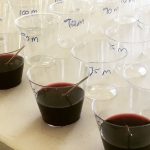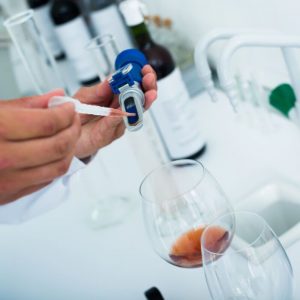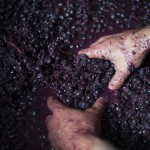Wine Blend Spotlight: Mettler Ranch GSM
A beautiful blend of three Rhone varietals: Grenache, Syrah, Mourvedre. All three of these varietals trace back to the Mediterranean coast and thrive in the Lodi climate. They blend poetically together, each bringing a different flavor profile. Grenache adds a fresh raspberry flavor. The Syrah brings savory dark fruit flavors and a velvety mouth-feel. Mourvedre adds a nice tannin structure and herbaceous aromas. A delicious wine to try!

You can ferment it a number of ways. You can do what is called a “field blend” and blend everything at crush. Or you ferment each varietal seperately. Either way makes a great wine. It all comes down to the equipment you have and the amount of time you have. If you don’t have a lot of storage vessels then doing a field blend is the way to go.
Field Blend Fermentation:
- Crushing and Fermenting: After harvesting, co-ferment the grapes together in the same fermentation vessel. This means that the Grenache, Syrah, and Mourvèdre grapes are all mixed together from the start. The co-fermentation process allows for the blending of flavors and characteristics at the earliest stage.
- Temperature Control: Control the fermentation temperature carefully, as each grape variety may have different requirements. Find a temperature that works well for all three varieties to ensure proper extraction of flavors and tannins.
- Taste and Adjust: Monitor the fermentation process and taste the wine to assess the development of flavors. Make any necessary adjustments, such as adding yeast or adjusting the temperature, to achieve the desired characteristics.
- Aging: After fermentation, age the wine in suitable containers, such as oak barrels or stainless steel tanks. Aging allows the flavors to meld and develop complexity.
- Bottling: Once the wine has aged to your satisfaction, bottle it. Label the bottles with the vintage and the type of field blend GSM.
- Enjoy: Once the wine has aged to your satisfaction, bottle it. Label the bottles with the vintage and the type of field blend GSM.
Creating a field blend GSM wine is a unique approach that requires careful planning and execution in the vineyard. It can result in a wine with distinctive characteristics that reflect the terroir and the synergy of the three grape varieties grown together.
Fermenting the Grapes Seperately:
- Fermentation: Fermenting each grape variety separately helps control the extraction and balance of flavors. Add yeast to start the fermentation process. Pro Tip: Use different yeasts for each batch and you will create even more complexity!
- Temperature: Monitor and control the fermentation temperature. Grenache, for example, generally benefits from higher fermentation temperatures, while Syrah and Mourvèdre might require lower temperatures to preserve their desired characteristics.
- Taste and Analyze: Taste the wines from each varietal to understand their individual characteristics. Analyze factors such as aroma, flavor, acidity, tannin, and alcohol content.
- Blending Trials: Once each wine has completed fermentation and has been aged to your liking, start experimenting with different blends. This is where the art of blending comes into play. Start with small trial blends and make adjustments to the ratios until you achieve the desired flavor profile and balance.
- Age the Blend: Blend the wines together and allow the blend to age in a suitable container, such as oak barrels or stainless steel tanks. The aging process helps the different components integrate and develop complex flavors. *For more information on againg your wines, check out this blog post
- Regular Tasting: Blend the wines together and allow the blend to age. The aging process helps the different components integrate and develop complex flavors.
- Bottle: Once you’re satisfied with the blend and the wine has aged to your liking, bottle it. Make sure to label the bottles appropriately, indicating the vintage and the blend.
- Enjoy: Allow the bottled wine to rest for a period before opening and enjoying. GSM blends often benefit from some additional bottle aging to reach their full potential.
GSM blends are known for their bold, rich, and complex flavor profiles, often characterized by red fruit, spice, and earthy notes. The proportions of each grape variety in the blend can vary, but Grenache is typically the dominant grape, with Syrah adding structure and Mourvèdre contributing depth and complexity. Experiment with different proportions to create your own unique GSM wine blend.
The Mettler Ranch wine grapes are available for purchase every Fall Season. If you are interested in the Mettler grapes we suggest making a pre-order by mid-August. For more information on the Mettler Ranch click here.
We’re here to help when you need it
Musto Wine Grape offers a variety of products as well as services including testing and support. Email sales@juicegrape.com or call (877) 812 – 1137 to speak with someone who can assist you.
Beginner Blending Wine by Winemaker Chris Pallatto
Click. With just a few sips, something clicked, and our winemaking group became better wine tasters and, hopefully, better winemakers. Our group held our first blending summit to assess our 2019 varietals and make a legendary blend. This post is about our process for blending wine and lessons learned.
Managing Expectations
To be clear, this is not an article for beginners by experts; rather, it chronicles our journey as beginners to become better winemakers. While I wish I could describe our wines with terms like “robust,” “fruit-forward,” or “hints of leather,” what I typically smell is just, well, wine. Bold and boozy, but just wine. Over the past year, our group’s goal has been to discuss and make notes of each tasting throughout the year and watch each varietal progress. As a spoiler, this blending experience did more for our collective palettes than any regular tasting.
Meet the wines:
- Wine #1: 2019 Malbec from Lodi. pH 3.43, TA of 7.2, and ABV 13.2%. Malolactic fermentation complete. Bulk aged in steel. D254 yeast.
- Wine #2: 2019 Cabernet Sauvignon from Lodi. pH 3.68, TA of 6, and ABV of 13.75%. Malolactic fermentation complete. Bulk aged in steel. D254 yeast.
Setting the stage
A recommended approach for blending is to assess each wine, make a note of the characteristics of each, and determine which wine would bring to the other and what it might be lacking. I’ve read a few different articles and feedback from winemaking groups that you should make tiny incremental adjustments of one or two percent until the blend is just right. We decided ahead of time that our group wasn’t likely to distinguish that difference and wanted to make bolder adjustments and refine if needed. I think the next time we do a blending, we’ll be ready for the first approach.
We marked and arranged plastic wine cups into rows of pre-determined blends for each taster with the 100% varietal on opposite ends of the row. We set up the rows as follows:
100% Cab
90/10 Cab/Malbec
75/25 Cab/Malbec
50/50 Cab/Malbec
25/75 Cab/Malbec
10/90 Cab/Malbec
100% Malbec
Let the tasting begin!
We wanted to stick with descriptors we could determine and collectively recognize as a group. Everyone tasted at the same time, and we went around our socially distanced circle and weighed in. We all sampled the Cab first, and it described it as very robust, with a long-lasting mouthfeel and high tannins. For a 10-month old wine, it’s ready to be bottled in a couple of months and will thrill its drinkers. We described the Malbec as “juicy” with lots of fruit flavor, a bit thinner, and young tasting with a hint of a green apple or astringent taste. We expect to bottle it happily in a couple of months, but suspect it will be much better in a year or two.
To a person, we agreed that the Cab was the star of the show. Interestingly, while we loved the Cab Sav as is, when we started to discuss what might make it better, we all arrived at the same conclusion. We anticipated that a bit of Malbec would add a bit of brightness to the Cab and round out the tannin mouthfeel.
After determining that we were leaning towards a Cab heavy blend, we tried the 50/50 blend. Universally, we agreed the astringent taste of the Malbec overpowered the Cab, and that blend was not better than either varietal on its own. It was also interesting to see that everyone picked up on the green apple or “young” taste of the Malbec.
We then tried the 90/10 Cab/Malbec blend and could distinguish a bit of the Malbec, but the addition did not make a substantial difference. We wanted to add a bit more fruit flavor and drop the tannins, so we agreed that this mixture wasn’t quite right. However, it was clear that we were heading in the right direction.
Lastly, well, almost lastly, we tried the 75/25 Cab/Malbec, and it was enjoyable. “Approachable” seemed like the perfect wine tasting descriptor. It was easy to drink and left a happy memory on your tongue. I prefer hoppy beers and tannin heavy wines but appreciate less dramatic flavor profiles.
We did try the more Malbec-y leaning blends, but for better or worse, we had made our minds up after the 50/50 blend that the sweet spot was going to be Cabernet Sauvignon heavy.
Next Steps
We bottled six gallons of our new “Calbec” blend and will let the wines mellow together for the next two months. Before bottling day, we may repeat and see how the stand-alone wines are maturing, particularly the young-tasting Malbec. We are also going to do a blind taste test with our wives on bottling day to see if there is a clear winner from an unbiased and willing audience.
Next year, I think we will be more intentional with our blends versus the pre-set blend levels. It was very telling that each of us collectively picked up the changes and agreed on the direction we wanted to go with the blend. If we were to incrementally move from the 100% Cab to the Cab blend by adding the Malbec, we’d end up where we needed to be. It was very enlightening to be critical of the wines and think of it in terms of each descriptor or profile as being on a scale.
There are certainly worse hobbies! I am not sure there is a right way or a wrong way, but the experience was certainly fun and a perfect reason to get the group together, taste our wine, and plan for our Fall pressing.
Chris Pallatto is an amateur winemaker and part of the Tight Knit wine group in Chester, CT, and a supporting member of the infamous DeFazio group in Prospect, CT.
Ready to make your own wine? Musto Wine Grape is here to supply you with everything you need to make the wine of your dreams. Email us at sales@juicegrape.com or call (877) 812-1137 to speak with someone who can get you started!
Winemaker Lab Skills Class – October 9th
Musto’s Winemaker Lab Skills Class will be held on Wednesday October 9th at 7:00PM.
Want clarification on TA, pH, and Adjusting Your Wine?
Then this is the class for you!
Professor Frank Renaldi will go over the following lab skills every winemaker needs. It can be difficult to feel comfortable testing your wine. However, Frank has some easy tricks and tips of how to test and adjust your wine.
Class Outline:
- Equipment & Supplies
- Volume Measurements
- Sugar, Content, & Adjustments
- Acidity, Content, & Adjustments
- pH
- Sulfites, Need, & Adjustments
- Blending
- MLF
- Sugar Addition
Sign up today and start sharpening your Winemaker Lab Skills!
Sign up via the website HERE or give us a call at 877-812-1137 to sign up over the phone. We look forward to seeing you in class. Cheers!
The Winemaker’s Think Tank: Vol 36 – “If I want to make a blend, do I mix the grapes together when I crush, or ferment them separately and blend later?”
What’s the Winemaker’s Think Tank?
Every Thursday we will post about a few frequently asked questions that our winemaker has answered. If you have a winemaking question you would like to have answered, please email us at support@juicegrape.com and we will try to get into next week’s post. Cheers! 🙂
If I want to make a blend, do I mix the grapes together when I crush, or ferment them separately and blend later?
There are many approaches to creating a blended wine and the chosen path is directly influenced by the desired end result. Blending at crush is often referred to as a field blend. The winemaker may choose to blend at crush when 80% of the blend is one grape. Using cabernet sauvignon as an example, a winemaker may add in a crate or two of Petite Syrah or Petite Verdot to enhance the dark color of the Cabernet Sauvignon. The winemaker may choose to add a crate or two of Cabernet Franc to enhance the spiciness and perceived acidity of the wine. Adding a small amount of a different grape to the larger percentage of the dominant grape in a blend will change the wine subtly, enhancing an aspect of the original grape that may be lacking such as color or acidity.
If the winemaker would prefer to have greater and much more finite control over the flavors in the resulting blend, fermenting each varietal individually would be more advantageous. Different yeast strains may be used on different varietals to enhance specific varietal characters. After a period of separate bulk aging, the wine maker can make different sample blends to determine the final blend of the wines they desire. Perhaps the entire quantity of a varietal will not be needed for the blend or perhaps only small additions of one varietal to another will be necessary to create a balanced final product. The winemaker can create more than one blend with a few separately vinified wines as changing the varietal percentages can greatly affect the final product.
We hope this information helps with your winemaking. If you have any follow up questions or winemaking questions in general, please email us at support@juicegrape.com.










Recent Comments